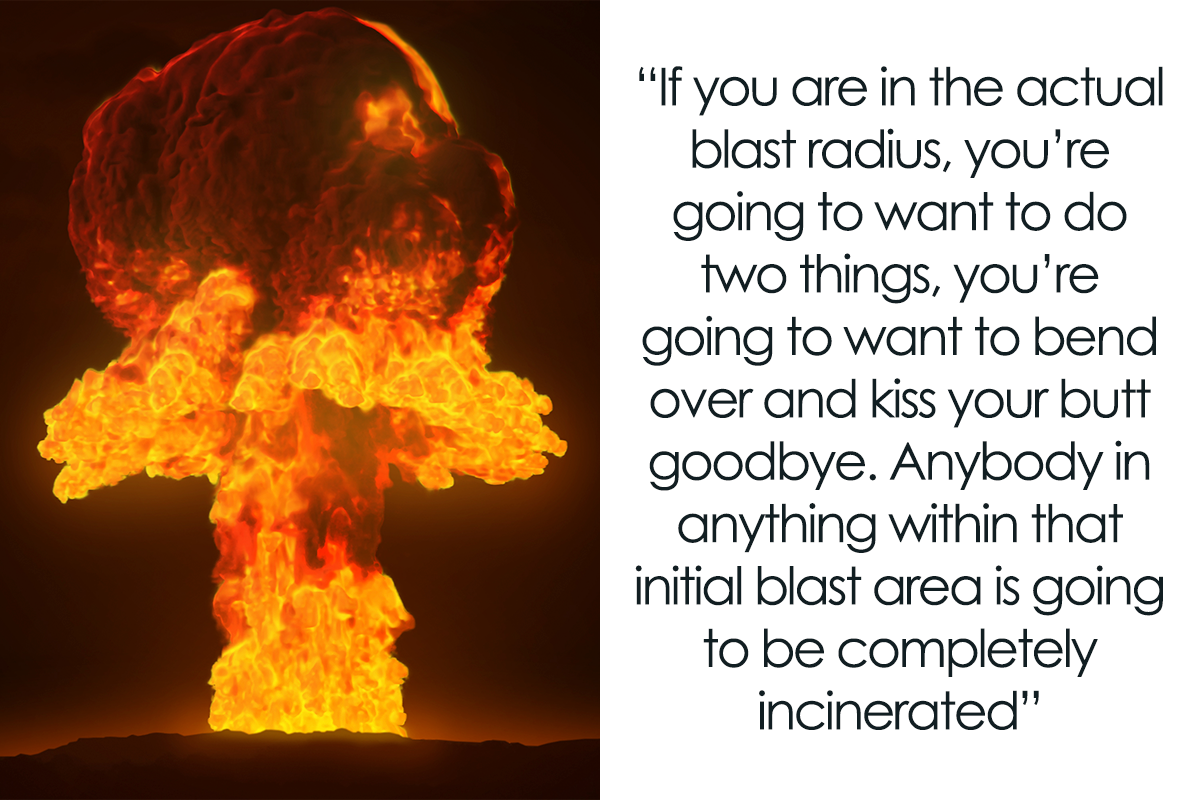
Guy Gives 8 Tips On What To Do In Case Of A Nuclear Explosion, Provided In The US Armed Forces Survival Manual
Given the whole situation with Ukraine and Russia, and the latter’s threats now involving nuclear weapons, many will agree that it’s high time to get a refresher on how to survive a nuclear explosion, but let’s hope it doesn’t happen cause the 2 we’ve already had were 2 too many.
Incidentally, a novice survivalist and off-grid outdoors lifestyle hobbyist, appropriately named Novice Prepper on TikTok, has shared some videos on how to do just that—survive a nuclear explosion.
More Info: TikTok | No Basement Edition
While everyone hopes this won’t be the case, being prepared for a nuclear explosion is something everyone should do, and this TikToker delivers
Image credits: Burnt Pineapple Productions
So, there’s a video floating about the internet that’s been going viral recently—and very appropriately so, as some nuclear weaponry threats have been thrown out there—so it’s nice to be prepared, just in case.
In his video, Novice Prepper effectively presented what the U.S. Armed Forces Nuclear, Biological, and Chemical Survival Manual said about surviving a nuclear blast.
Novice Prepper gave a brief explanation on how to best avoid the consequences of a nearby nuclear explosion
Image credits: novice_prepper
He elaborates that if you are in the actual blast radius, then there is practically no chance of you surviving that as everything within this area is completely incinerated. Considering that the blast of the nuclear bomb used in Hiroshima was around 1.5 miles (2.4 kilometers), modern bomb blasts can reach a radius of 3 to 8 miles (4.8 to 12.8 kilometers), so as NP explains, you can “bend over and kiss your [butt] good-bye”.
If that is not the case, however, and you’re around 50 to 100 miles (80 to 160 kilometers) away from the explosion, you’re gonna want to make a family action plan ahead of time, which would include everything from communication to supplies to safe locations to meet.
The key element in surviving a nuclear explosion is having sufficient cover, i.e. a basement
Image credits: novice_prepper
Ideally, you’d want to get yourself and everyone you love into a basement as most basements are encased in cinder blocks, concrete, and earth, which greatly decrease the spread of nuclear radiation and fallout.
Another thing you can do is cover up your windows with sandbags, dirt, wood insulation or anything that would help stop radiation from seeping into your home.
If you do end up getting exposed to radiation and fallout, take off your clothes, take a shower and put on some fresh clothes. If you react quickly enough, you can avoid up to 95% of contamination that could very seriously affect your skin and hair.
Another key is being far enough because if you’re within around 8 miles (or 12 kilometers) of the blast, you might end up incinerated along with your house
Image credits: novice_prepper
Now that you’re safe in your underground shelter, stay there for as long as you can, given your food and water reserves. It is said that nuclear fallout decreases significantly over time—by a factor of 10 every 7 hours, meaning that 48 to 72 hours (or 2 to 3 days) ought to be enough for levels to drop to non-lethal levels, but this 7-10 rule is considered a rule of thumb based on observed data, and hence can be a bit inaccurate.
Should you also get in contact with fallout, it is recommended to take a shower and change clothes, which gets rid of up to 95% contamination
Image credits: novice_prepper
After this video, a lot of people started asking about a situation if you don’t have a basement. Effectively, you do more of the same—encapsulate yourself in as much insulation as possible. Find the center-most point in your home on the first floor. It can be a room or a closet, but if that isn’t an option, build a fort.
Novice Prepper was also asked to provide a “no basement edition” which is more or less the same, except you bunker yourself in the center of your house
Image credits: novice_prepper
Again, use plastic, tarp, wood, blankets or anything else you can find to cover up the windows and doors. Now, nothing works as good as having a basement, but having nothing is absolutely not an option, and even things like plastic sheets will help reduce radiation levels, even if it is on a lower protection level.
Needless to say, stay there for the same amount of time, make sure you have enough food, water, and perhaps a bucket as a toilet. Remember the 7-10 rule. Also, don’t forget that you also have neighbors and if they have a basement, they will also quite likely be very welcoming. Given you’re not a neighbor from hell.
Image credits: novice_prepper
Now, if you want an even more detailed version of this, you can either get yourself a copy of said book, or you can do the faster thing and refer to Ready.Gov’s extensive, but still quick, guide on the hows and whats of nuclear explosions.
You can check out the now-viral video below
@novice_prepper How to Survive a Nuclear Explosion #survival #ww3 #nuclearbunker #military #survivalguide ♬ Creepy and simple horror background music(1070744) – howlingindicator
Novice Prepper also followed up with an emergency bag video explaining essential things to have prepared in case of an emergency
Image credits: novice_prepper
The initial video has managed to garner 4.8 million views with over 630,000 likes as of this article. The follow-up no-basement edition popped up on his channel the next day, and has gotten another 770,000 views and 62,600 likes.
So, remember these tips, find yourself a good basement (or even a bomb shelter), stay safe out there, and let us know your thoughts on this in the comment section below!
Myd ad, US Navy, on surviving nuclear war: "You don't. Drive into the nearest big city target area and get it over with."
I am SO ANGRY that ONE mentally deficient, limp dicked old man can hold this threat over the entirety of the rest of the civilised world.
Load More Replies...Can we PLEASE STOP featuring idiots talking about stuff they don't understand on tikfuck? Can we please stop featuring tikfuck altogether? It's a friggin' propaganda platform CONTROLLED BY A REGIME COMMITTING GENOCIDE AGAINST THEIR OWN PEOPLE. Why does nobody give a single fúck, seriously?
The fact that China owns TikTrash doesn’t mean that they made this video.
Load More Replies...Very difficult to explain a nuclear blast effects on the environment unless your familiar with radiation effects on the environment. If you are within the blast zone GOOD BYE… of the outskirts of that zone it will be toxic for years.
When was this written. The guide I mean. While I would not doubt it would help you survive long enough to die from cancer. Remember some of these guides thought that if you cover your eyes with your hands while hiding under a desk would save you.
Those school procedures of "duck and cover" were merely to give people a sense of security, an idea that they COULD do something, even if all they did was reduce the panic. In the case of covering your face with your hands immediately after the flash the intent wasn't to protect you from the blast or the radiation, but from flying debris. Such a blast could shatter windows dozens of miles away from ground zero.
Load More Replies...This is stupid, all it would do is scare your family. If a nuclear war begins everyone is screwed unless you're lucky enough to live somewhere like Vanuatu.
Or are a millionaire/billionaire and have built a state of the art shelter.
Load More Replies...Pro-tip, go outside, have a drink, enjoy the blast and be gone. Fast and clean, unlike that idiot in his 50's basement fort where he never can get out again because his now radioactive house is crumbled down on him.
Hey Dr.Prepper, are you serious? Washing off the contamination? With what, contaminated water, standing on contaminated land in radiating air, changing contaminated clothes with contaminated clothes. And afterwards? Radiation decreases within the 7/10 rule? Does the radiation know that? What about Tchernobyl, Fukushima, Bikini, Mururoa and your Nevada Desert. You can write your survival hacks on paper and wash your ass with. If only one Rocket is launched, all of them will be, that means a couple of thousands. A nuclear weapon is not a brick that makes a dent in your f***** helmet, it is a weapon of mass destruction and you should know that for several reasons. First, you guys invented them, then you used them twice in Japan, you tested them more than thousand times, with your troops watching the test like a movie but without Popcorn and second you were afraid of Saddam Hussein having them and using them against US, which was a lie of your government and third you have them.
When the nuclear weapons are launched a worldwide nuclear contamination and destruction will be the result. Goodbye major cities of the world, goodbye New York, Paris, London, Tokyo, Berlin and Castrop-Rauxel. When i was in German Army my Lieutenant asked me what would i do when the nuclear bombs are exploding. He wants to hear that i will put on my mask and ABC clothes and stay ready for combat. I replied that i would have a look for a beer, smoke a cigarette and sit under a tree and then shoot myself, because it is the only thing that you can do. The only impact i would like to see at the moment is the impact of my fist in your face Sgt. Prepper stupid piece of s****, f**** id***. I wish you a nice "duck and cover"
Load More Replies...I explained to my younger sister that if there's a nuclear fallout and we're able to GET somewhere, we go to my old school. It was built before WWII and has tons of heavy cinderblocks. We go into the gym, in the direct center of it, and we wait it out. That, or we go into our basement. We have a ton of food down there, running water, and clothing. I hope it doesn't come to this, but if it does, I'm prepared.
Surviving the nuclear winter is a much bigger challenge.
Load More Replies...I never thought I’d live to see a day where I’d need to be reading and making a mental note of this kind of thing.
I'm also reading it advise. Sadly I'm probably within a blast radius
Load More Replies...I'm probably one of the last kids to have learned "duck and cover". This was back in the 60's. Told us to get under our desks. Yay! That'll work.
Nope.I did that once or twice in the 80s. Of course, we were all to young to really understand. We were making fart noises and such.
Load More Replies..."If you're in the initial blast radius, Kiss your a$$ goodbye"...Well no $h!t Sherlock. That's kind of a no brainer. Those will be the fortunate ones.
Back in olden times when we loaded nukes onto the ship ( USN) we were told to tuck our pants into our socks and button our shirts to the top. It was good for a laugh and about as useful as this crap.
That's not entirely laughable. Plutonium-based weapons will emit alpha-particle radiation, which is readily blocked by something as thin as a sheet of paper. Alpha emitters are really only dangerous to humans if you get them on you, or inside you through inhalation or ingestion.
Load More Replies...Dear pussy, we have that info in 7th grade in Lithuuania, from 1996. In my personal opinion, it's better to die in combat before that. Poor kids and woman, cause of one psicho orc.
When I was in Elementary school, we were a 2 lane highway away from a nuclear power plant (since decommissioned). We would have drills, pulling all the curtains together, then cowering under our desks. As an adult, I realized that this really wouldn't have helped.
If I'm at home when there's an explosion, the clothes on me and the clothes in my wardrobe will be all the same. Except for maybe a stash the army or some special service is going to have for their own people, in that radius, where do I get "fresh" clothes?
If we even get to that level I would happily go with the first step: Kiss my ass goodbye...and thats it...why would I even want to live in an post apocalyptic kind of world if the present one is tough and unlivable as it is... I just hope Putin loses his d**k measuring contest...
What? No fancy power armour? No adorable canine companion? Well screw that, I’m for the blast zone and a f*****g last shot of good whiskey.
is it just me or does the top of the explosion pic at the top look a little like a dog?
Duck and cover was just an attempt to provide a sense of false hope and calm a terrified populace.
Load More Replies...This gave me goosebumps. I’ve thought about nuclear attacks as something that would probably never happen in my lifetime (I know, I’m overly optimistic sometimes). Reading this made me think how likely of a scenario this has become. I’m truly scared that some idiot with access to nuclear bombs would actually do something stupid.
This is super helpful although I’m praying to god that I never have to experience this
I hate to tell all of you this, but the reason the Gov't recommends you go to a "shelter" area is that it's easier for them to collect and identify all the bodies, and get an accurate count of the dead.
LOL, like there'd be anyone left to count or ID bodies.
Load More Replies...All of you who denounce boomers need to remember that they lived through years of this fear - yes they may have been able to buy all the things, but it was against the backdrop of impending doom. For decades.
Christ. Why are preppers always the ones you'd totally not want to be breeding to repopulate the earth.
Myd ad, US Navy, on surviving nuclear war: "You don't. Drive into the nearest big city target area and get it over with."
I am SO ANGRY that ONE mentally deficient, limp dicked old man can hold this threat over the entirety of the rest of the civilised world.
Load More Replies...Can we PLEASE STOP featuring idiots talking about stuff they don't understand on tikfuck? Can we please stop featuring tikfuck altogether? It's a friggin' propaganda platform CONTROLLED BY A REGIME COMMITTING GENOCIDE AGAINST THEIR OWN PEOPLE. Why does nobody give a single fúck, seriously?
The fact that China owns TikTrash doesn’t mean that they made this video.
Load More Replies...Very difficult to explain a nuclear blast effects on the environment unless your familiar with radiation effects on the environment. If you are within the blast zone GOOD BYE… of the outskirts of that zone it will be toxic for years.
When was this written. The guide I mean. While I would not doubt it would help you survive long enough to die from cancer. Remember some of these guides thought that if you cover your eyes with your hands while hiding under a desk would save you.
Those school procedures of "duck and cover" were merely to give people a sense of security, an idea that they COULD do something, even if all they did was reduce the panic. In the case of covering your face with your hands immediately after the flash the intent wasn't to protect you from the blast or the radiation, but from flying debris. Such a blast could shatter windows dozens of miles away from ground zero.
Load More Replies...This is stupid, all it would do is scare your family. If a nuclear war begins everyone is screwed unless you're lucky enough to live somewhere like Vanuatu.
Or are a millionaire/billionaire and have built a state of the art shelter.
Load More Replies...Pro-tip, go outside, have a drink, enjoy the blast and be gone. Fast and clean, unlike that idiot in his 50's basement fort where he never can get out again because his now radioactive house is crumbled down on him.
Hey Dr.Prepper, are you serious? Washing off the contamination? With what, contaminated water, standing on contaminated land in radiating air, changing contaminated clothes with contaminated clothes. And afterwards? Radiation decreases within the 7/10 rule? Does the radiation know that? What about Tchernobyl, Fukushima, Bikini, Mururoa and your Nevada Desert. You can write your survival hacks on paper and wash your ass with. If only one Rocket is launched, all of them will be, that means a couple of thousands. A nuclear weapon is not a brick that makes a dent in your f***** helmet, it is a weapon of mass destruction and you should know that for several reasons. First, you guys invented them, then you used them twice in Japan, you tested them more than thousand times, with your troops watching the test like a movie but without Popcorn and second you were afraid of Saddam Hussein having them and using them against US, which was a lie of your government and third you have them.
When the nuclear weapons are launched a worldwide nuclear contamination and destruction will be the result. Goodbye major cities of the world, goodbye New York, Paris, London, Tokyo, Berlin and Castrop-Rauxel. When i was in German Army my Lieutenant asked me what would i do when the nuclear bombs are exploding. He wants to hear that i will put on my mask and ABC clothes and stay ready for combat. I replied that i would have a look for a beer, smoke a cigarette and sit under a tree and then shoot myself, because it is the only thing that you can do. The only impact i would like to see at the moment is the impact of my fist in your face Sgt. Prepper stupid piece of s****, f**** id***. I wish you a nice "duck and cover"
Load More Replies...I explained to my younger sister that if there's a nuclear fallout and we're able to GET somewhere, we go to my old school. It was built before WWII and has tons of heavy cinderblocks. We go into the gym, in the direct center of it, and we wait it out. That, or we go into our basement. We have a ton of food down there, running water, and clothing. I hope it doesn't come to this, but if it does, I'm prepared.
Surviving the nuclear winter is a much bigger challenge.
Load More Replies...I never thought I’d live to see a day where I’d need to be reading and making a mental note of this kind of thing.
I'm also reading it advise. Sadly I'm probably within a blast radius
Load More Replies...I'm probably one of the last kids to have learned "duck and cover". This was back in the 60's. Told us to get under our desks. Yay! That'll work.
Nope.I did that once or twice in the 80s. Of course, we were all to young to really understand. We were making fart noises and such.
Load More Replies..."If you're in the initial blast radius, Kiss your a$$ goodbye"...Well no $h!t Sherlock. That's kind of a no brainer. Those will be the fortunate ones.
Back in olden times when we loaded nukes onto the ship ( USN) we were told to tuck our pants into our socks and button our shirts to the top. It was good for a laugh and about as useful as this crap.
That's not entirely laughable. Plutonium-based weapons will emit alpha-particle radiation, which is readily blocked by something as thin as a sheet of paper. Alpha emitters are really only dangerous to humans if you get them on you, or inside you through inhalation or ingestion.
Load More Replies...Dear pussy, we have that info in 7th grade in Lithuuania, from 1996. In my personal opinion, it's better to die in combat before that. Poor kids and woman, cause of one psicho orc.
When I was in Elementary school, we were a 2 lane highway away from a nuclear power plant (since decommissioned). We would have drills, pulling all the curtains together, then cowering under our desks. As an adult, I realized that this really wouldn't have helped.
If I'm at home when there's an explosion, the clothes on me and the clothes in my wardrobe will be all the same. Except for maybe a stash the army or some special service is going to have for their own people, in that radius, where do I get "fresh" clothes?
If we even get to that level I would happily go with the first step: Kiss my ass goodbye...and thats it...why would I even want to live in an post apocalyptic kind of world if the present one is tough and unlivable as it is... I just hope Putin loses his d**k measuring contest...
What? No fancy power armour? No adorable canine companion? Well screw that, I’m for the blast zone and a f*****g last shot of good whiskey.
is it just me or does the top of the explosion pic at the top look a little like a dog?
Duck and cover was just an attempt to provide a sense of false hope and calm a terrified populace.
Load More Replies...This gave me goosebumps. I’ve thought about nuclear attacks as something that would probably never happen in my lifetime (I know, I’m overly optimistic sometimes). Reading this made me think how likely of a scenario this has become. I’m truly scared that some idiot with access to nuclear bombs would actually do something stupid.
This is super helpful although I’m praying to god that I never have to experience this
I hate to tell all of you this, but the reason the Gov't recommends you go to a "shelter" area is that it's easier for them to collect and identify all the bodies, and get an accurate count of the dead.
LOL, like there'd be anyone left to count or ID bodies.
Load More Replies...All of you who denounce boomers need to remember that they lived through years of this fear - yes they may have been able to buy all the things, but it was against the backdrop of impending doom. For decades.
Christ. Why are preppers always the ones you'd totally not want to be breeding to repopulate the earth.
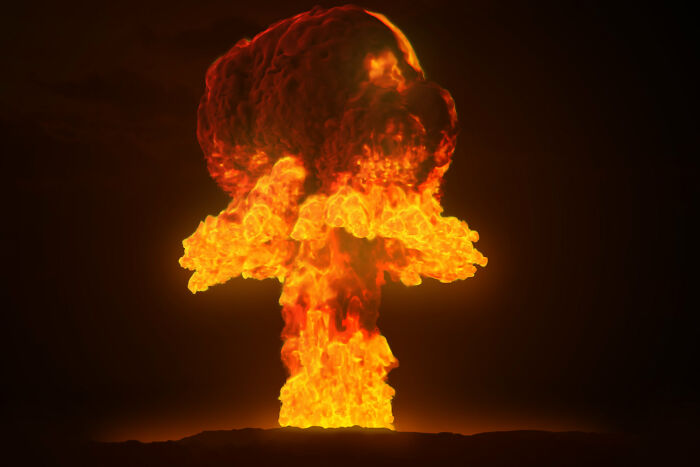
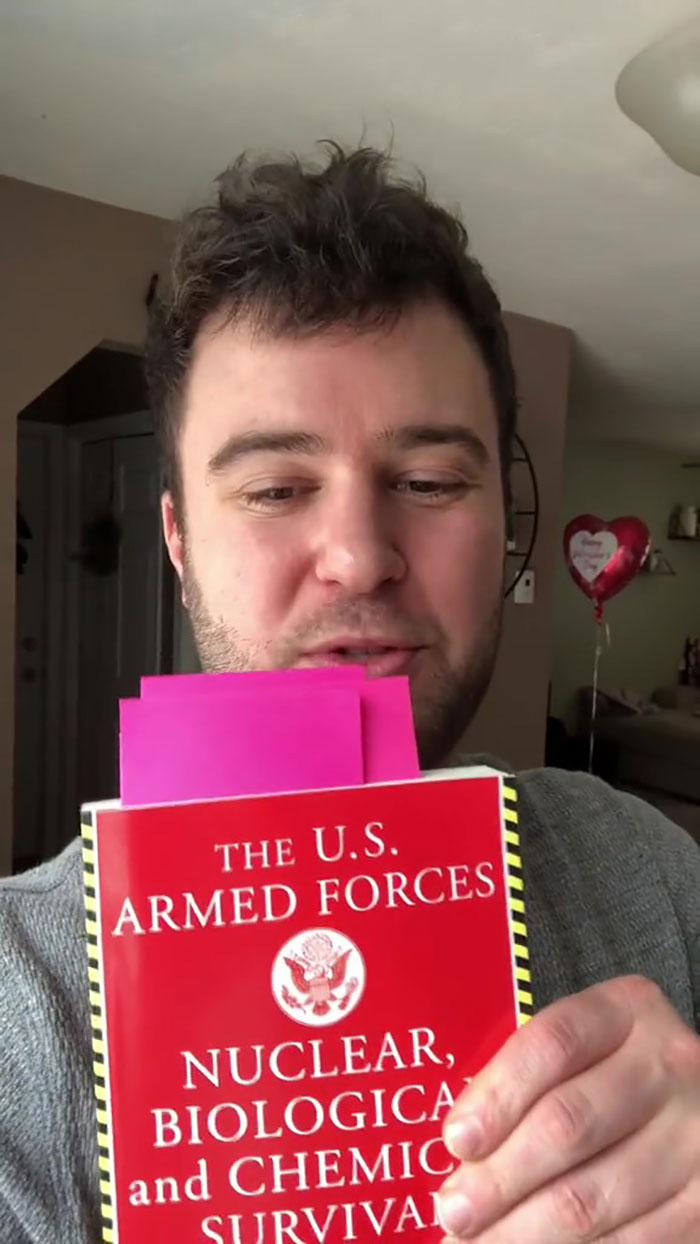
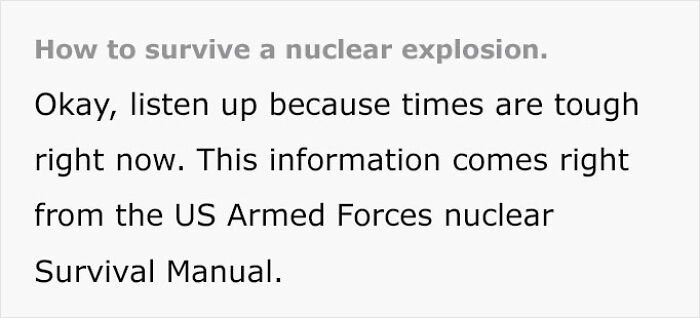
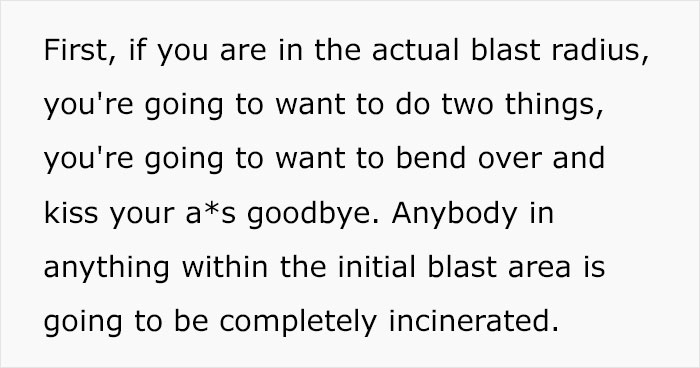
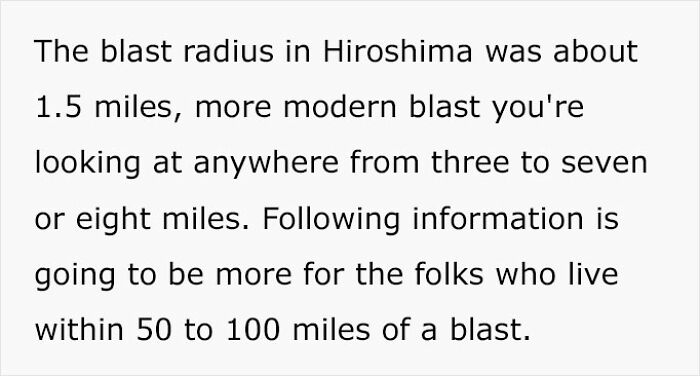
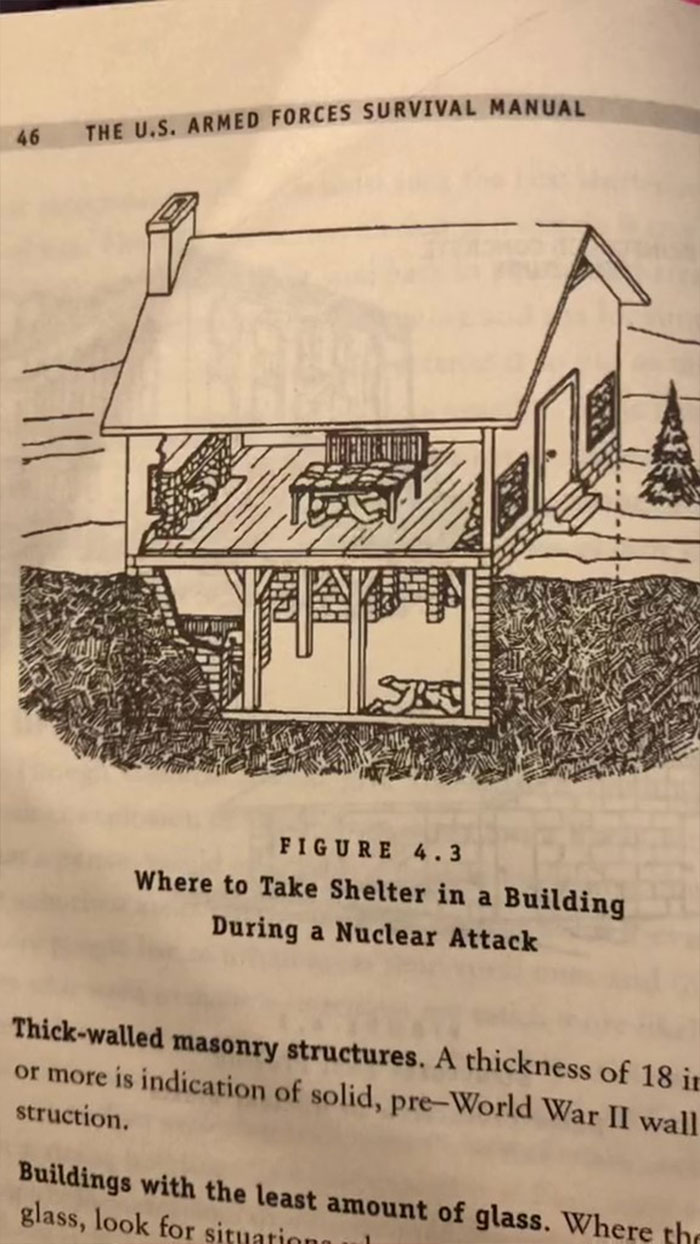
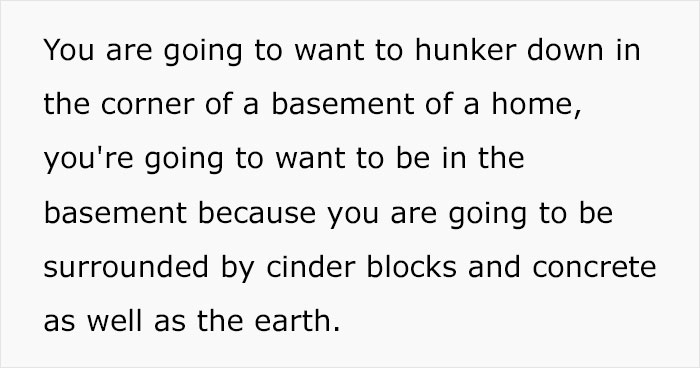
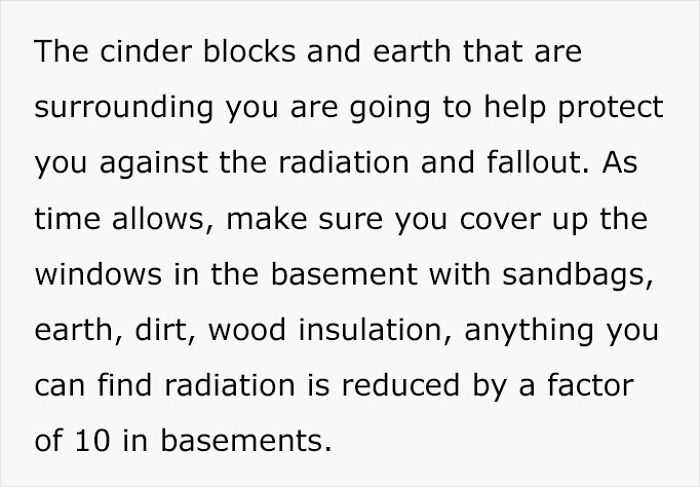
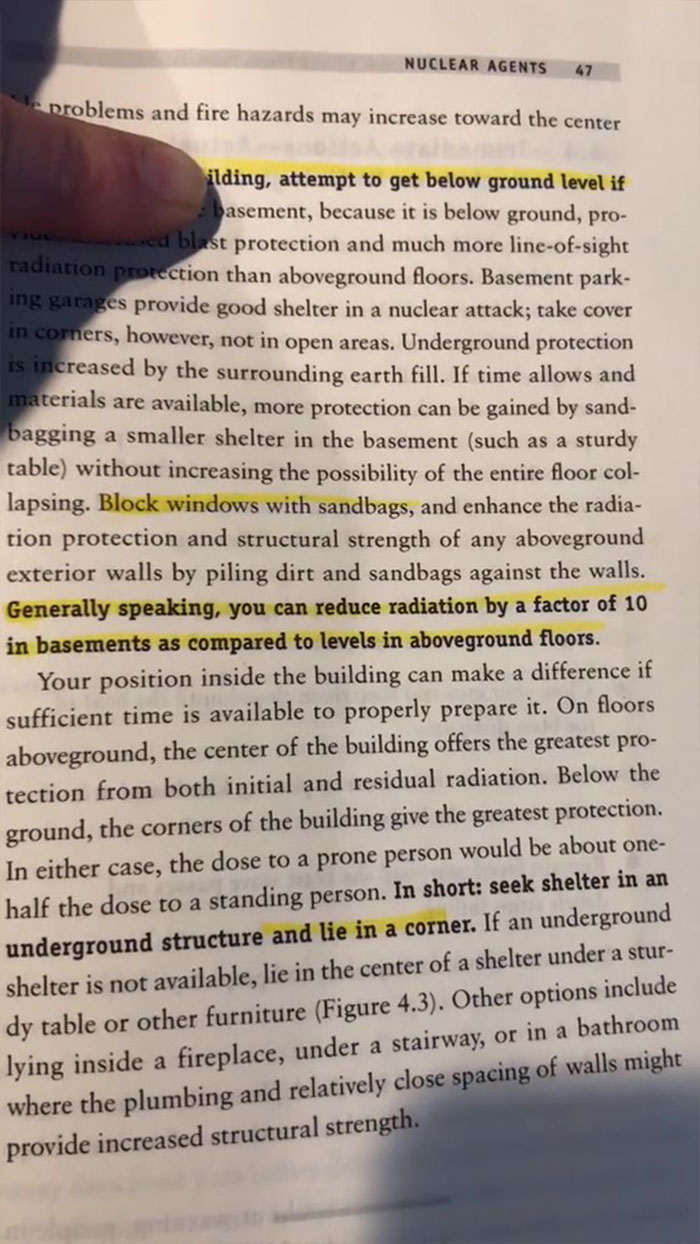
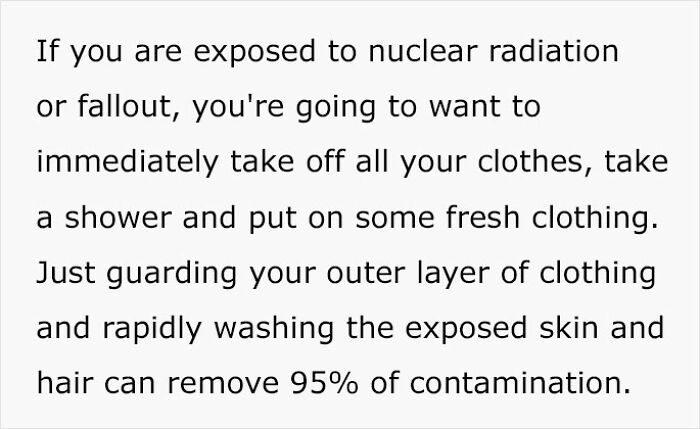
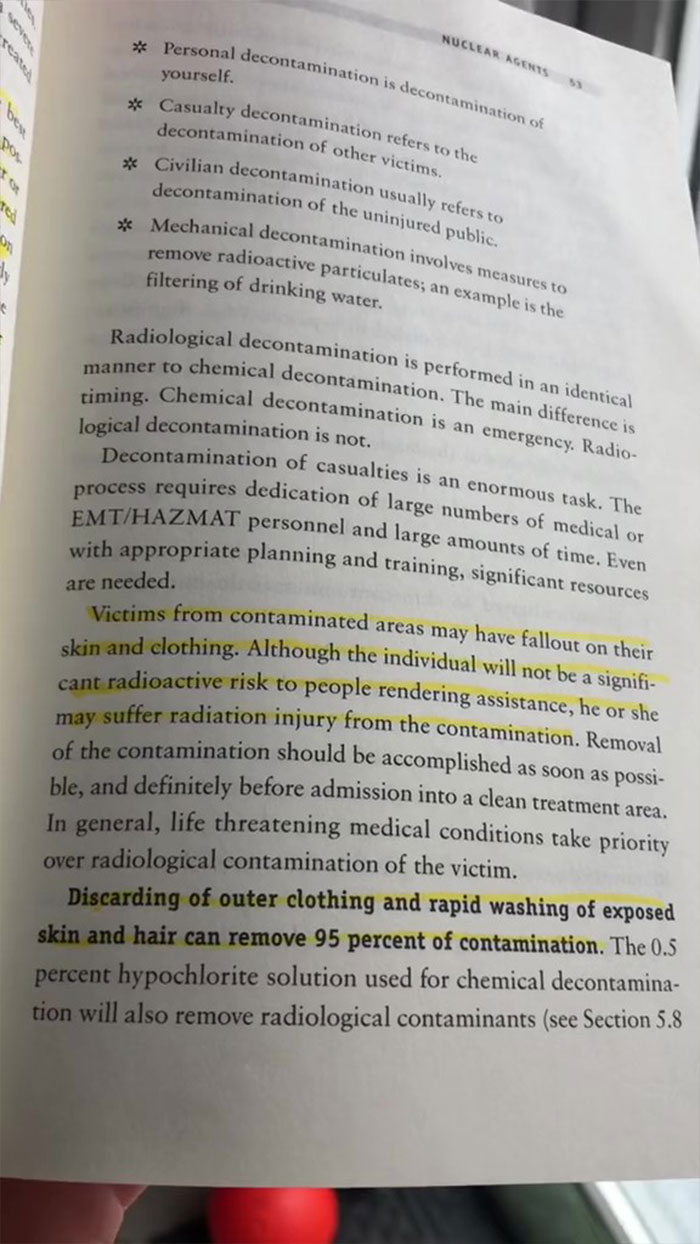
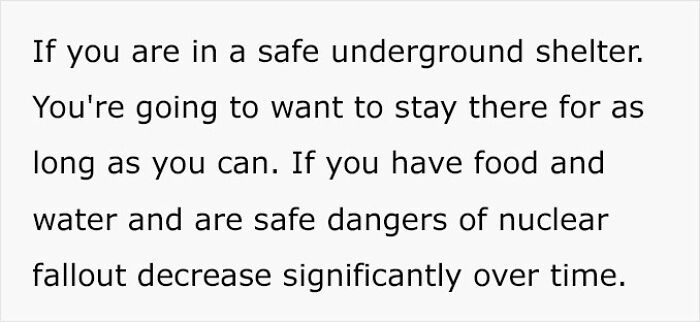
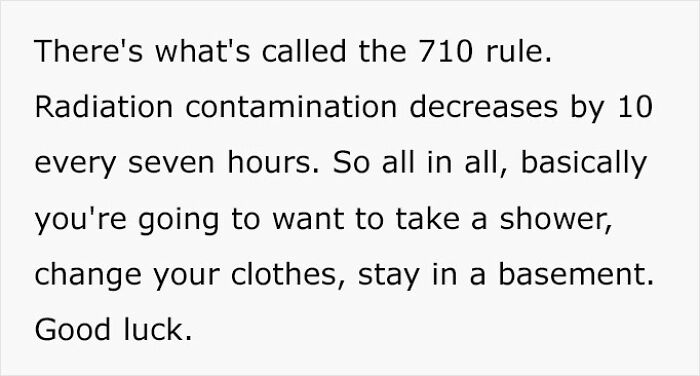


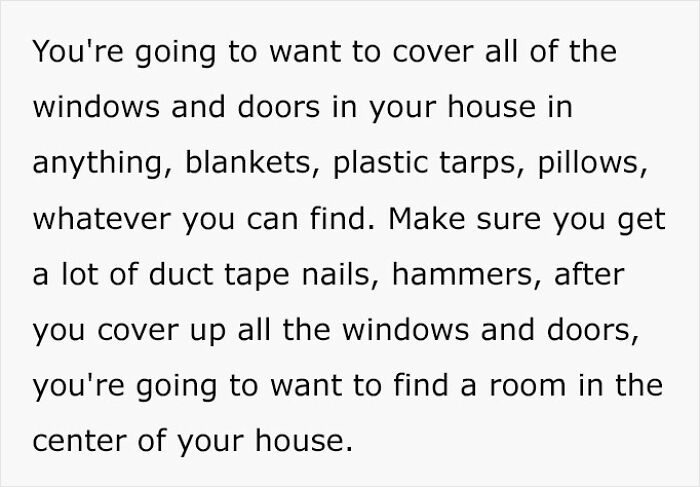
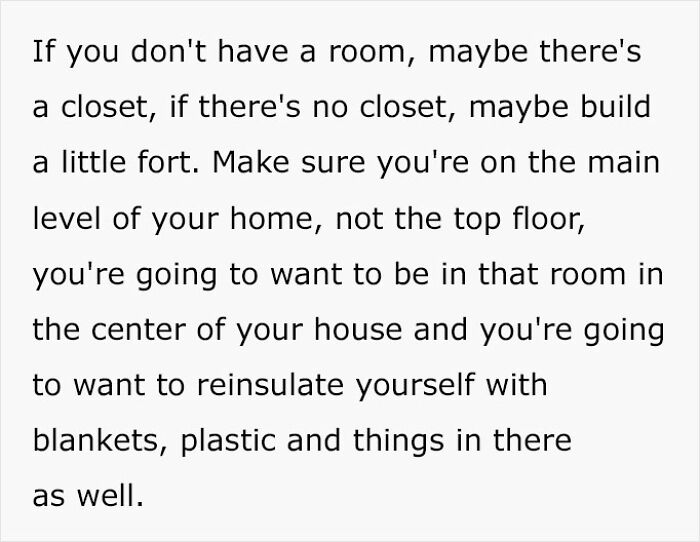
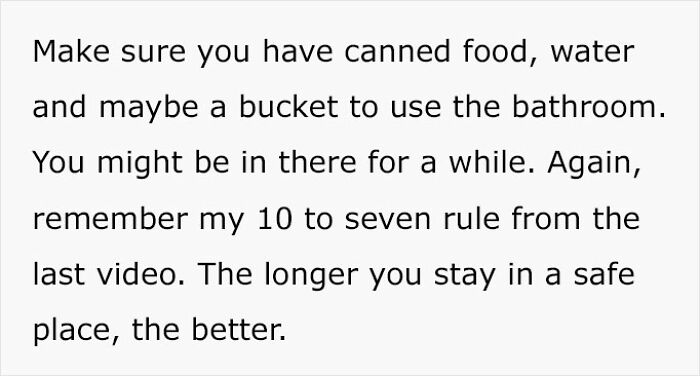
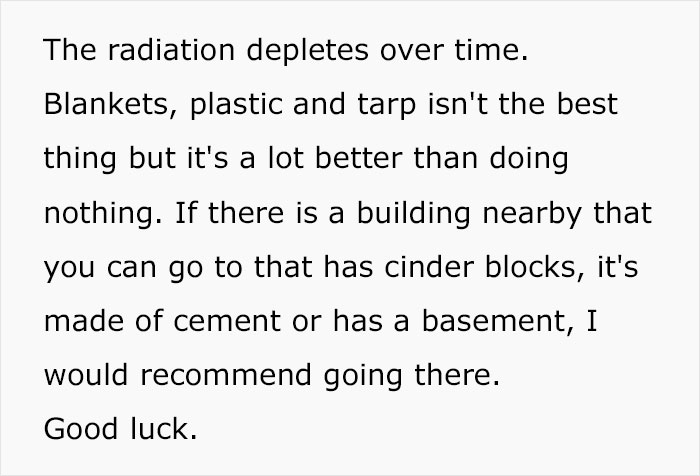
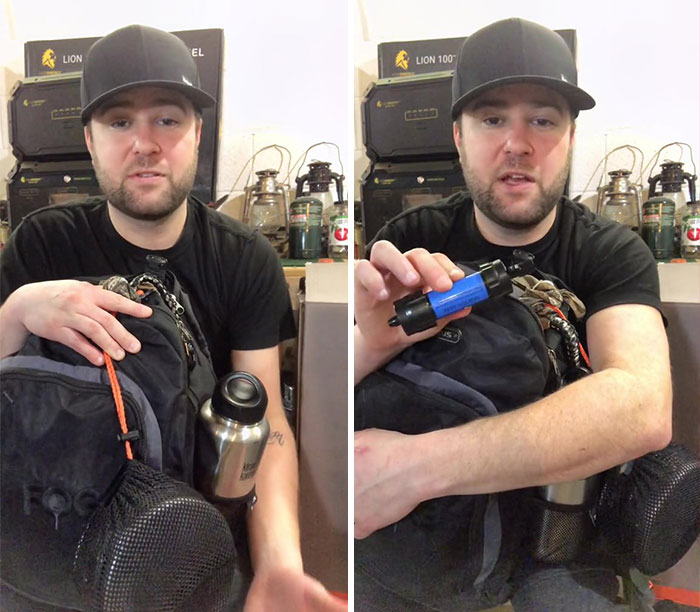



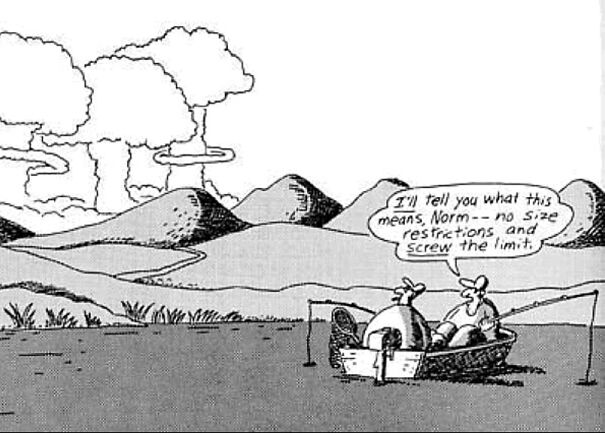

54
84